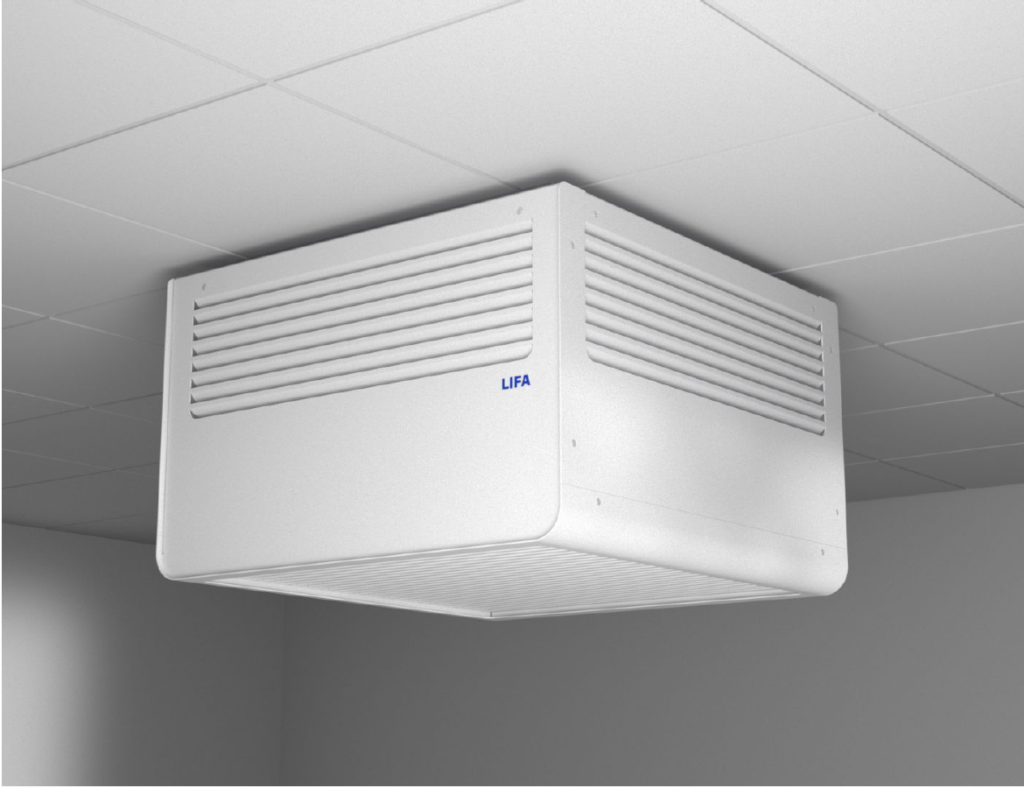* Products in development
LIFA, a patent-pending technology, uses UVC to neutralize bioaerosols and to help prevent the spread of infectious diseases between occupants of closed environments. LIFA uses ultraviolet light, which destroys the genetic material of microorganisms and effectively eliminates them.
Airborne pathogen neutralization technology using germicidal ultraviolet light (UVC) offers many advantages over conventional ventilation approaches.
Ultraviolet light destroys the genetic material of pathogens – the DNA of bacteria and fungi and the RNA of viruses -, which prevents them from reproducing and effectively eliminates them.

Conventional ventilation reduces the concentration of pathogens by the principle of dilution. This approach leads to an exponential decay characterized by a rate equal to the fresh air flow [liters/min] divided by the volume [liters] of the room to be decontaminated. UVC technology also provides an exponential decay, but with a higher characteristic rate due to the high efficiency of pathogen neutralization (viruses and bacteria) specific to the applied UVC rays.
Air disinfection under real-world conditions using germicidal UVC at the top of the room and good air mixing has been shown to produce the equivalent of several room air changes per hour in a quiet, safe and sustainable manner. This performance is superior to mechanical ventilation and room air cleaners.
LIFA offers significant advantages in terms of recurring operating costs. LIFA consumes less than 30 W, which is 40-50% less than typical air exchanger technologies and heat recovery units. Typical air exchangers and heat recovery units have an energy recovery of approximately 55-65%, which results in significant heating costs in ventilated spaces. Since LIFA does not exchange outside air, no additional heating is produced by this
technology. LIFA has no filters to change and no consumables to spend money on. Ventilation systems with air ducts require periodic maintenance, which LIFA does not need either.
LIFA is designed to be installed with a ceiling fan and is powered by the same circuit as said fan. This gives it a distinct advantage over the installation of an air exchanger with heat recovery, which requires a complex and expensive installation of air ducts from the outside as well as an interior distribution in the room.
The high power UVC light emitting diode (LED) technology has recently reached commercial maturity, which allows the development of new air cleaning products like LIFA. LIFA offers a superior performance to conventional technologies at a selling price of less than $1000. This price is advantageous when compared to typical air exchangers and heat recovery
units.
LIFA has no moving parts and is silent. Typical air exchangers and heat recovery units generate a minimum of 2.5 sones (41 decibels) of noise that can affect the concentration of room occupants when the unit is installed on the premises.
The LIBU | Life Button, based on a patented technology, is an antimicrobial and self-sterilizing elevator button that eliminates more than 99% of bacterial and viral pathogens left by users’ fingers. Our technology breaks the chain of contagion that is particularly present in hospitals, healthcare facilities, commercial structures and apartment buildings.
The LIBU self-disinfecting elevator button uses a patented technology that deploys UVC radiation in order to destroy surface microbes in seconds, which eliminates the chain of contagion that is particularly present in hospitals, healthcare facilities, commercial structures and apartment buildings.

 LIBU automatically disinfects the button’s surface.
LIBU automatically disinfects the button’s surface.
LIBU, a patented technology, is a self-disinfecting elevator button that uses UVC to eliminate microbes on its surface in seconds, thus breaking one of the chains of contagion of infectious diseases present in hospitals, healthcare environments and public and multi-residential buildings.